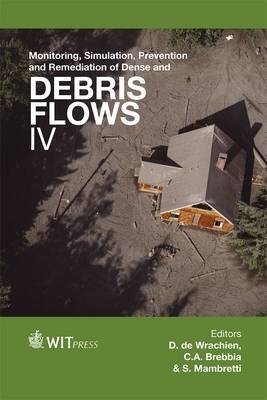
Monitoring, Stimulation, Prevention and Remediation of Dense and Debris Flows
WIT Press (Verlag)
978-1-84564-586-1 (ISBN)
Contents Section 1: Debris flow modelling Empirical methods for the estimation of debris flow deposition areas; Field investigation and finite element modelling of a progressive debris slide in the Indian Himalayas; Debris-flow runout distance: laboratory experiments on the role of Bagnold, Savage and friction numbers; Geophysical study and structural modelling of a mass movement in upper Austria; Debris flow rainfall thresholds in Val Canale Valley: first steps into their redefinition Section 2: Monitoring and measurement Two methods for measuring internal velocity of debris flows in the laboratory; A review on acoustic monitoring of debris flow Section 3: Risk assessment Risk assessment method of debris flow occurrence utilizing a digital terrain model; Hot pyroclastic deposit as lahar resistor: a case study of Gendol River after the Mt. Merapi 2010 eruption Section 4: Sediment transport and debris flow Modelling soil erosion and sediment transport under different land management options in a southern Italy watershed; Bedload transport as an indicator of contemporary transformations of arctic fluvial systems; Riparian forest structure, vegetation cover and flood events in the Piave River; Assessing short term erosion-deposition processes of the Brenta River using LiDAR surveys; Medium term fluvial island evolution in relation with flood events in the Piave River; The influence of storm based events on the suspended sediment flux in a small scale river catchment in Ireland Section 5: Protective barriers Protection against debris flows with 13 flexible barriers in the Milibach River (Canton Berne, Switzerland) and first event analysis; Examination regarding the design method of a protective barrier for debris flow Section 6: Landslide phenomena Evaluation of landslide causative factors towards efficient landslide susceptibility modelling in the Cameron Highlands, Malaysia; Framework of human reliability analysis in a geotechnical risk assessment for hillside development; Investigating rainfall-induced unsaturated soil slope instability: a meshfree numerical approach
| Erscheint lt. Verlag | 29.5.2012 |
|---|---|
| Reihe/Serie | WIT Transactions on Engineering Sciences ; 73 |
| Zusatzinfo | Illustrations |
| Verlagsort | Southampton |
| Sprache | englisch |
| Maße | 155 x 230 mm |
| Themenwelt | Naturwissenschaften ► Geowissenschaften ► Geologie |
| Naturwissenschaften ► Physik / Astronomie ► Strömungsmechanik | |
| Technik ► Bauwesen | |
| Technik ► Maschinenbau | |
| ISBN-10 | 1-84564-586-3 / 1845645863 |
| ISBN-13 | 978-1-84564-586-1 / 9781845645861 |
| Zustand | Neuware |
| Haben Sie eine Frage zum Produkt? |
aus dem Bereich


